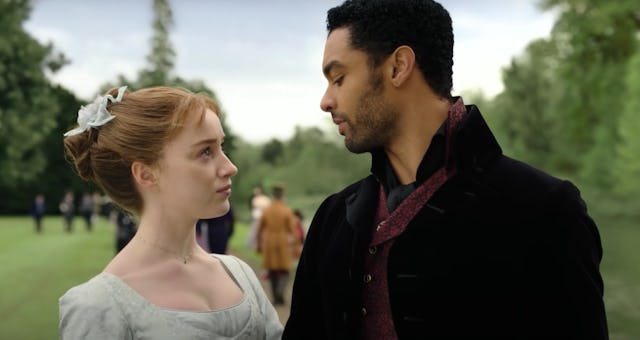Bridgerton Is The Best Sex Ed (But Not In The Way You Think)
The moment that jerked me right out of the show – and disappointed me as a longtime romance fan.

For over a decade, I was in a book club for two with my 90-year-old Nana, in which we read Regency romance novels. We started with the chaste Georgette Heyer but quickly moved into the sexier offerings that have traditionally been dismissed as “bodice rippers.” Even if you’re not a fan, you’ve probably browsed them surreptitiously in the racks at the drugstore or at the checkout line at the supermarket (back in the days when there were such things), drawn in by vivid covers that promised abundant lust. Nana and I shared hundreds of these books until she died in 2020 at nearly 101 years old. My dad laughingly referred to me as her “dealer,” because I brought her shopping bags full and took them back after she’d read them — she was too embarrassed to donate them to the library in her retirement home.
I often called Nana to hear what she thought about her most recent delivery, prompting her reflections on her own life and relationships. She claimed she didn’t read the books for the sex because “that button doesn’t work anymore, dear,” but rather for the intelligent portrayal of familial and romantic relationships. We spent hours unpacking different characters’ hopes and dreams, disappointments and failures and what they brought up for her. These books were a channel through which Nana shared nearly a hundred years of a life lived.
But for those of us for whom “that button” still works, the sex is pretty good, too. While long written off as misogynistic, modern Regency romance novels are chock full of female empowerment and representations of feminist sex. They are populated by vast numbers of men eager to go down on their female sexual partners. Read Beyond Heaving Bosoms: The Smart Bitches Guide to Romance Novels to appreciate just how much the romance genre now does for furthering the cause of equitable sexual relationships and female pleasure.
So you can imagine how excited I was when Bridgerton, based on Julia Quinn’s excellent book series, was released on Netflix in late 2020 — produced by none other than Shonda Rhimes, who is revered for portraying powerful women unafraid to demand what they want in and out of the bedroom. I believed she would do true justice to both the passion and the feminism in these books.
And then I started watching the series — which, to be clear, is generally a delicious confection — with my 13-year-old daughter. We reached the climactic (literally and figuratively) scene where Daphne Bridgerton loses her virginity to her new husband, the Duke of Hastings, and I gasped in horror. Dear reader, my shock was not because our heroine was no longer a virgin, and not because I was watching a show so explicit with my daughter, either. I was aghast because Daphne was depicted in an exquisite close-up orgasming as her husband did nothing more than abruptly put his penis in her vagina. (No, they did not show that part close-up.)
I immediately paused the Roku and turned to my daughter, asking her with a slightly manic edge: “What did they just show us?” She calmly replied: “Daphne having an orgasm.” My interrogation went to graduate level: “Yes, they showed her having an orgasm because her husband put his penis inside her vagina. But it’s bullshit. What did he need to find in order for her to really have an orgasm?” My daughter — with a tone that said “please let this conversation be over quickly” — replied: “Her clitoris.”
I threw my hands in the air and shouted “Hallelujah.” Thank God. I had done my job as a parent. At least on this score.
- My daughter knew what an orgasm was.
- She knew that the old penis-in-the-vagina approach was likely not going to lead to a female orgasm.
- She understood that the clitoris was the likely path to orgasm.
- My daughter was willing to speak the word clitoris out loud.
I was feeling pretty damned successful. My kid was utterly mortified, but at least she knew where things stood, which is which is all you can really ask from sex ed.
I was also pissed, because all I could do was imagine all of the teen girls and young women watching that scene and thinking: I guess that’s what sex should look like. But it’s not what sex should look like, and not only because he didn’t find her clitoris (though that was bad enough).
Had my daughter not been close to abandoning me in the basement, I would have added that the scene disappointed me because it was deadly serious, with no talking or laughing or fumbling or awkwardness. It only furthered the veneer our culture tells us about sex — that it’s silent and graceful. I call BS. Positive portrayals of inexperienced sex should depict the ridiculousness of two human bodies meeting for the first time and all of the wonderful absurdity that entails. It requires in-the-moment honesty and laughter, something my Nana understood.
As Season 2 of Bridgerton drops this weekend, I am praying that the feminist sex so smartly portrayed in the modern Regency romance genre is in better evidence than in Season 1. I hope that next time I pause Bridgerton in our at-home sex ed tutorial, it will be to point out what they got right not what they got wrong. And Nana, I sure wish I could watch with you.
Vanessa Kroll Bennett is the co-host of The Puberty Podcast; the founder of Dynamo Girl, a company using sports and puberty education to empower kids; and the author of the Uncertain Parenting Newsletter, musings on raising adolescents. You can follow her on Instagram @vanessakrollbennett.
This article was originally published on